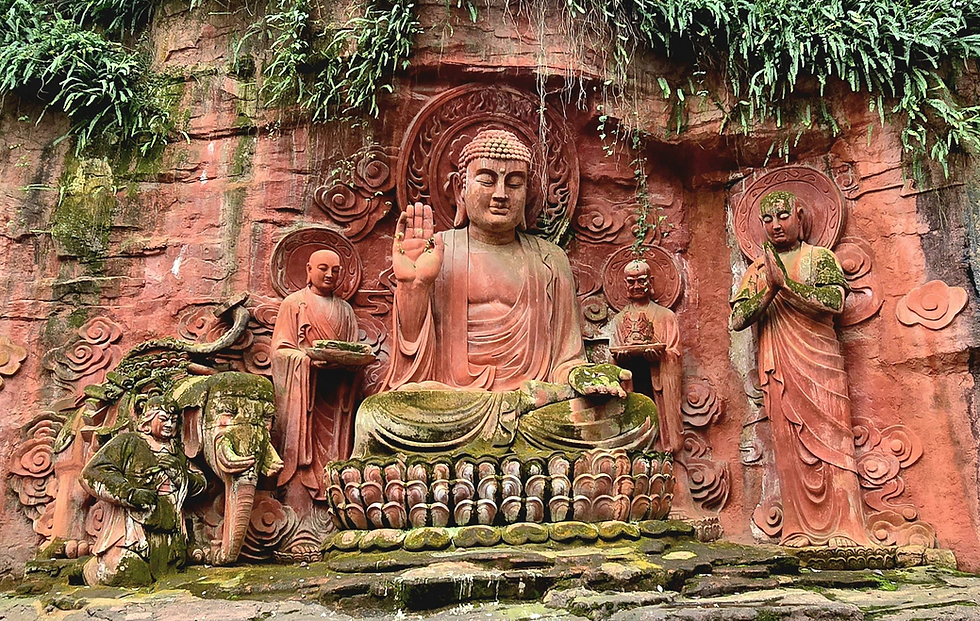The Leshan Buddha - Guardian of the Rivers
- Shannon
- May 21
- 4 min read
In the heart of Sichuan Province, nestled at the confluence of the Min, Dadu and Qingyi Rivers, the Leshan Giant Buddha looms as one of China’s most awe inspiring historical landmarks. Towering at 71 metres high, this colossal statue is the largest stone Buddha in the world and remains a profound testament to ancient Chinese ingenuity and spiritual devotion. Carved directly into the red sandstone face of Mount Lingyun, the serene figure of the seated Maitreya Buddha gazes out over the turbulent waters below, a quiet guardian whose presence has endured for more than a millennium.

The origin of this immense endeavour dates back to the Tang Dynasty in the early 8th century, when a Buddhist monk named Hai Tong envisioned a sacred protector to calm the dangerous river currents that plagued the region. The treacherous confluence of the three rivers often resulted in deadly floods and shipwrecks, endangering local fishermen and merchants. Hai Tong believed that the spiritual presence of the Buddha, carved into the cliffside overlooking the rivers, would bring peace to the waters and safeguard those who relied on them. This vision was more than spiritual symbolism, it was a radical fusion of religious devotion and practical engineering.

In 1996, the Unesco World Heritage Committee included this ancient site in the World Cultural & Natural Heritage list
Undeterred by a lack of financial support, Hai Tong famously embarked on the project with extraordinary resolve, even resorting to begging for funds. When local officials attempted to siphon off donations, he is said to have gouged out his own eyes in a dramatic gesture of spiritual sincerity and defiance, proclaiming that he was not building the Buddha for wealth or personal gain. His shocking act has become one of the many legends surrounding the statue’s construction, blurring the lines between history and hagiography. Though Hai Tong did not live to see the project completed, his unwavering dedication inspired generations of disciples and local craftsmen who continued the colossal task long after his death.

Leshan remains the world tallest pre-modern stone Buddha. To understand it's size, each foot can accommodate 100 people standing on it.
It took more than 90 years for the Leshan Buddha to be fully realised and it was finally completed in 803AD. Ironically, the construction of the statue fulfilled its original purpose in an unexpected way. The vast amounts of sandstone chipped away during the carving process fell into the river below, altering the flow and reducing the violence of the currents. As a result, the waters at the base of the statue became calmer and safer for navigation, a remarkable case in which spiritual intention and physical transformation merged to create real world impact. In this way, the Leshan Buddha didn’t just symbolise protection, it actively provided it.

The ancient Haoshang moon bridge is considered one of the prettiest stone bridges in China
Equally impressive is the statue’s sophisticated drainage system, a feature that has ensured its endurance for over twelve centuries. Ancient engineers embedded a complex network of gutters and channels within the Buddha’s hair, ears, chest and shoulders. These cleverly concealed systems divert rainwater and reduce erosion, preserving the integrity of the sandstone beneath. This kind of early hydrological engineering was far ahead of its time and it’s a major reason why the Buddha has survived Sichuan’s humid climate and monsoon seasons for so long.
The surrounding cliffs are carved with narrow winding pathways and tombs, created as a ritual route for monks and pilgrims. The walls contain Buddhist carvings which are thought to be some of the oldest in the world
Nevertheless, the statue faces new threats in the modern era. Rapid urbanisation, air pollution and acid rain have begun to take their toll. The once pristine sandstone has blackened in places, most notably on the Buddha’s nose, due to chemical weathering. Efforts to preserve the monument have become increasingly complex, requiring a blend of traditional conservation methods and modern scientific intervention. Despite these challenges, the Leshan Giant Buddha remains a revered cultural and spiritual symbol, standing tall above the rivers it was meant to tame, an enduring sentinel carved from devotion, ingenuity and stone.

Location : Lingyun Street, Shizong District, Leshan, Sichuan, China
How to get there : The Leshan Buddha is 126km's from Chendgu. There is a high speed train for 104 yuan, running every half an hour from Chengdu to Mount Emei, the journey will take about an hour & a half. Alternatively there are many busses running to the area from Chengdu and this journey takes about 2 hours.
Attraction Info : The entry fee is 80 yuan. The easiest way to view the whole buddha is from the river. The ferry costs 120-150 yuan per person and takes approximately 1/2 an hour return. If you're up for a 3 hour challenge, you can forgo the ferry and walk up to the top. Access to the Wulong Temple & Mahao Cliff Tomb are included in the entry fee. Opening hours are 7:30am - 6:30pm between April & October and 8am - 5:30pm between October & March.
乐山大佛
Thanks for reading about the The Leshan Buddha - Guardian of the Rivers. Check out more destinations here!









